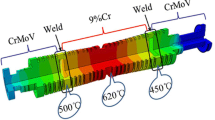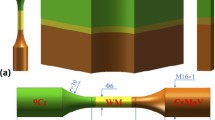Abstract
Numerical investigation has been employed to analysis stress distribution in 9Cr/2.25Cr dissimilar welded rotor undergoing welding and heat treatment in order to help optimize structural design. The simulated residual stress on inner and outer cylindrical surface has been validated with experimental data. Distribution and evolution of welding residual stress along weld center line through thickness has also been investigated. It is found that expansion due to martensitic phase transformation in cap weld and shrinkage in nominal HAZ determines the distribution of residual stress on outer cylindrical surface. Meanwhile, expansion caused by martensitic phase transformation and bending effect in annular structure is responsible for the evolution and distribution of through-wall residual stress. Distribution and peak value of through-wall welding residual stress remains after the weld height reaches a certain value (it is about 30% thickness from the inner cylindrical surface in this work), which provides a possibility to predict stress distribution with less time. Meanwhile, post weld heat treatment (PWHT) can release residual stress effectively. Hence, more attention has been paid to as-welded residual stress. Compared with 2.25Cr weld filler, 9Cr weld filler induces greater compressive hoop stress in the newly deposited weld metal and decreases the peak value of tensile hoop stress under it because of greater martensitic phase transformation expansion in cooling process and smaller yield stress at low temperatures.






















Similar content being viewed by others
References
Kern T-U, Staubli M, Scarlin B (2002) The European efforts in material development for 650 C USC power plants-COST522. ISIJ Int 42(12):1515–1519
Rothwell J, Abson D (2010) Performance of weldments in advanced 9% Cr steel–‘FB2’. Mater High Temp 27(3):253–264
Shige T et al (2001) Development of large-capacity, highly efficient welded rotor for steam turbines. Mitsubishi Heavy Ind 38(1):6–11
Nose M et al (2017) Computational crack propagation analysis with consideration of weld residual stresses. Eng Fract Mech 182:708–731
Mirzaee-Sisan A, Wu G (2019) Residual stress in pipeline girth welds-a review of recent data and modelling. Int J Press Vessel Pip 169:142–152.
Wang H et al (2018) Effect of chemical dilution and the number of weld layers on residual stresses in a multi-pass low-transformation-temperature weld. Mater Des 160:384–394
Schaupp T et al (2017) Welding residual stresses in 960 MPa grade QT and TMCP high-strength steels. J Manuf Process 27:226–232
Obeid O et al (2017) A parametric study of thermal and residual stress fields in lined pipe welding. Therm Sci Eng Prog 4:205–218
Xia J, Jin H (2018) Analysis of residual stresses and variation mechanism in dissimilar girth welded joints between tubular structures and steel castings. Int J Press Vessel Pip 165:104–113
Dodge MF, Gittos MF, Dong H, Zhang SY, Kabra S, Kelleher JF (2015) In-situ neutron diffraction measurement of stress redistribution in a dissimilar joint during heat treatment. Mater Sci Eng A 627:161–170
Laha K (2014) Integrity assessment of similar and dissimilar fusion welded joints of Cr-Mo-W ferritic steels under creep condition. Procedia Eng 86:195–202
Li Y et al (2018) Alloy design of welding filler metal for 9Cr/2.25 Cr dissimilar welded joint and mechanical properties investigation. Weld World 62.6:1137–1151
Jiang W et al (2005) Finite element simulation of multipass welding: full three-dimensional versus generalized plane strain or axisymmetric models. J Strain Anal Eng Des 40.6:587–597
Deng D, Murakawa H (2006) Numerical simulation of temperature field and residual stress in multi-pass welds in stainless steel pipe and comparison with experimental measurements. Comput Mater Sci 37(3):269–277
Vangi D (1994) Data management for the evaluation of residual stresses by the incremental hole-drilling method. J Eng Mater Technol 116(4):561–566
Hu M et al (2018) A new weld material model used in welding analysis of narrow gap thick-walled welded rotor. J Manuf Process 34:614–624
DuPont JN, Marder AR (1995) Thermal efficiency of arc welding processes. Weld J 74(12):406–416
Brickstad B, Josefson BL (1998) A parametric study of residual stresses in multi-pass butt-welded stainless steel pipes. Int J Pres Ves Pip 75.1:11–25
Guguloth K, Roy N (2018) Study on the creep deformation behavior and characterization of 9Cr-1Mo-V-Nb steel at elevated temperatures. Mater Charact 146:279–298
Song S-H, Wu J, Wei XJ, Kumar D, Liu SJ, Weng LQ (2010) Creep property evaluation of a 2.25 Cr–1Mo low alloy steel. Mater Sci Eng A 527(9):2398–2403
Liu C, Zhang JX, Xue CB (2011) Numerical investigation on residual stress distribution and evolution during multipass narrow gap welding of thick-walled stainless steel pipes. Fusion Eng Des 86(4–5):288–295
Acknowledgments
The authors are also grateful to the help of Wangteng Cai during the preparation of the report.
Funding
This work is funded by the Shanghai Turbine Plant and Project 51775300 supported by NSFC.
Author information
Authors and Affiliations
Corresponding author
Additional information
Publisher’s note
Springer Nature remains neutral with regard to jurisdictional claims in published maps and institutional affiliations.
Highlights
1. Effect of cap weld on stress distribution on outer surface has been explained with 9Cr/2.25Cr dissimilar welded rotor.
2. Mechanism of stress distribution and evolution in welded ferritic annular structure has been clarified in detail.
3. Distribution and peak value of through-wall welding residual stress remains after the weld height reaches a certain value (it is about 30% thickness from the inner cylindrical surface in this work), which provides a possibility to predict stress distribution with less time.
Rights and permissions
About this article
Cite this article
Hu, M., Li, K., Li, S. et al. Numerical investigation on stress distribution and evolution in 9Cr/2.25Cr dissimilar welded rotor undergoing welding and heat treatment. Weld World 64, 1981–1995 (2020). https://doi.org/10.1007/s40194-020-00977-1
Received:
Accepted:
Published:
Issue Date:
DOI: https://doi.org/10.1007/s40194-020-00977-1




